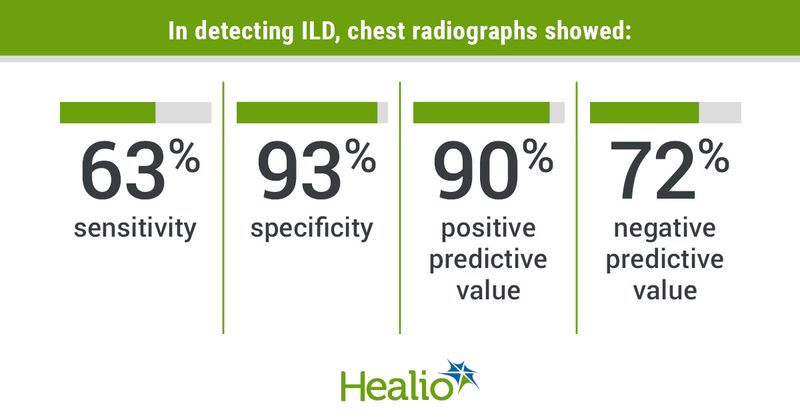Chest X-ray may miss 30% of ILD cases
Compared with high-resolution CT, chest radiography appeared less accurate in detecting interstitial lung disease, according to a study published in Annals of the American Thoracic Society.
“In this study, we found that the chest radiograph had good specificity but modest sensitivity for detecting ILD,” Sahand Ghodrati, MD, internal medicine resident at UC Davis Health, and colleagues wrote. “These data suggest that using chest radiography to screen for fibrotic ILD will miss nearly 30% of cases.”

In a single-center, retrospective study, Ghodrati and colleagues analyzed 180 adults (mean age, 69.7 years; 60% men; 72.2% white) with incident ILD from the UC Davis ILD registry between 2014 and 2021 to evaluate the diagnostic accuracy of chest radiography in detecting ILD. Overall, 35.6% of patients had idiopathic pulmonary fibrosis, 25.6% had connective tissue disease associated-ILD, 22.2% had unclassifiable ILD, 12.8% had chronic hypersensitivity pneumonitis and 3.9% had other non-IPF idiopathic interstitial pneumonia.
Researchers checked the radiograph findings against results from high-resolution CT (HRCT) taken afterward, which they described as the gold standard in diagnosing diffuse parenchymal lung disease.
Researchers deemed ILD apparent in chest radiographs if reticulation, reticular, fibrosis, fibrotic or interstitial were mentioned in the reports.
Of the total cohort, 114 patients had a chest radiograph with mention of ILD, whereas the remaining 66 had a radiograph without mention of ILD.
Both groups of patients had comparable baseline lung function, which researchers noted is important because it demonstrates that chest radiography does not just detect cases of severe ILD.
Researchers found that chest radiography had a sensitivity of 63%, specificity of 93%, positive predictive value of 90% and a negative predictive value of 72% in detecting ILD compared with HRCT.
Additionally, more cases with definite or probable usual interstitial pneumonia HRCT patterns were observed in chest radiographs than indeterminate and alternative patterns, according to researchers.
Patients with a radiograph that mentioned ILD had a significantly shorter time to pulmonologist evaluation and a 40% higher likelihood for evaluation (HR = 1.4; 95% CI, 1.03-1.91) than those who did not have mentioned ILD.
“Chest radiography is likely to miss a large proportion of patients with fibrotic ILD, but ILD is likely when features are detected,” Ghodrati and colleagues wrote. “A chest radiograph showing features of ILD should be followed up with HRCT, while ILD should remain among the differential diagnoses in those without ILD mentioned. Further research is needed to validate these findings and further elucidate factors underpinning diagnostic delays in patients with fibrotic ILD.”
